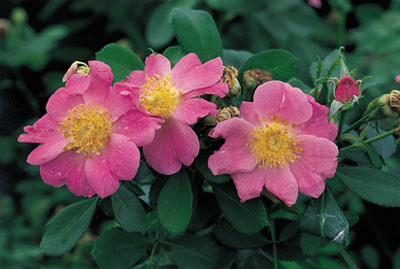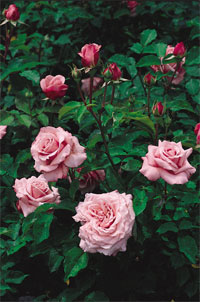Rose Cuttings – April, 2009

‘Basye’s Blueberry’ (shown also as a shrub, below) has been an important part of the Antique Rose Emporium’s breeding program.
Blazing a New Trail — Texas Pioneer Roses


‘Belinda’s Dream’, developed by Dr. Robert Basye, has been named an EarthKind™ rose and a Texas Superstar™.
Texas is steeped in history, both horticultural and political. Sam Houston, Stephen F. Austin, Anson Jones, F. J. Lindheimer, Gideon Lincecum, George Englemann and John James Audubon are just a few of the names commonly found among those of our early Texas pioneers and naturalists.
To memorialize some of these major figures in the state’s rich history, the Antique Rose Emporium (ARE) created the Pioneer Roses, which were bred and chosen for their beauty and ease of care. These new roses bear the names of historic Texas leaders, along with other symbolic names such as ‘Pioneer Spirit’, ‘Star of the Republic’ and ‘Republic of Texas’.
Our Pioneer Rose breeding program began in 1992, when an experimental cross with a hybrid musk, ‘Buff Beauty’, was made with one of David Austin’s roses, ‘Heritage’. The resultant seedling developed into a shrub similar to ‘Heritage’ but with apricot flowers similar to the other parent, ‘Buff Beauty’. This rose was named in honor of Carolyn Hairston, the wife of the owner of the 1860s Hairston homestead, where ARE now resides.
Realizing the potential, we became more intent on the possibilities of improving the garden virtues of some of the old roses that we grow and love.
We developed a relationship with Dr. Robert Basye, a math professor at Texas A&M University in nearby College Station. An amateur rose breeder, Dr. Basye utilized in his breeding trials, wild species roses like R. wichuriana and R. carolina, which seemed to have had a greater immunity to blackspot and mildew. Several of his roses marketed commercially through us include ‘Belinda’s Dream’, which later earned the distinction of being designated an EarthKind™ rose and a Texas Superstar™.
It was Dr. Basye’s rose ‘Basye’s Blueberry’ that was very instrumental in our breeding program. It was selected for its nearly thornless, repeat-blooming, hip-producing qualities, as well as having the original wild rose makeup, giving it increased disease-resistance capabilities. Crosses of ‘Basye’s Blueberry’ were made with other roses in our collection like ‘The Fairy’, ‘Carefree Beauty’, ‘Granny Grimmets’, ‘Crimson Glory’, ‘Graham Thomas’ and ‘Iceberg’. Only the most promising seedlings were saved, in hopes of creating a more interesting form and flower. These roses were often used for second- and third-generation crosses in order to get the best qualities, since desirable, but often dormant, recessive characteristics like large flowers, more petals, etc., can show up in the succeeding generations.
We selected characteristics based on criteria we felt contributed to an ideal garden rose: vigor, repeat bloom, bright and large flowers, diverse forms (climbers and shrubs) and fragrance. In upcoming articles, we will profile our Pioneer Roses. All are beautiful additions to the garden, but the best virtues of these Pioneer Roses are their toughness and resiliency, much like the pioneers they honor.
About the author: Mike Shoup is the owner of the Antique Rose Emporium. Visit their Brenham and San Antonio display gardens for endless ideas on landscaping with roses. To order roses online, visit www.weAREroses.com.

